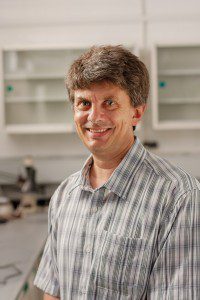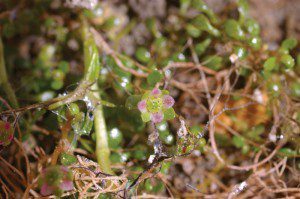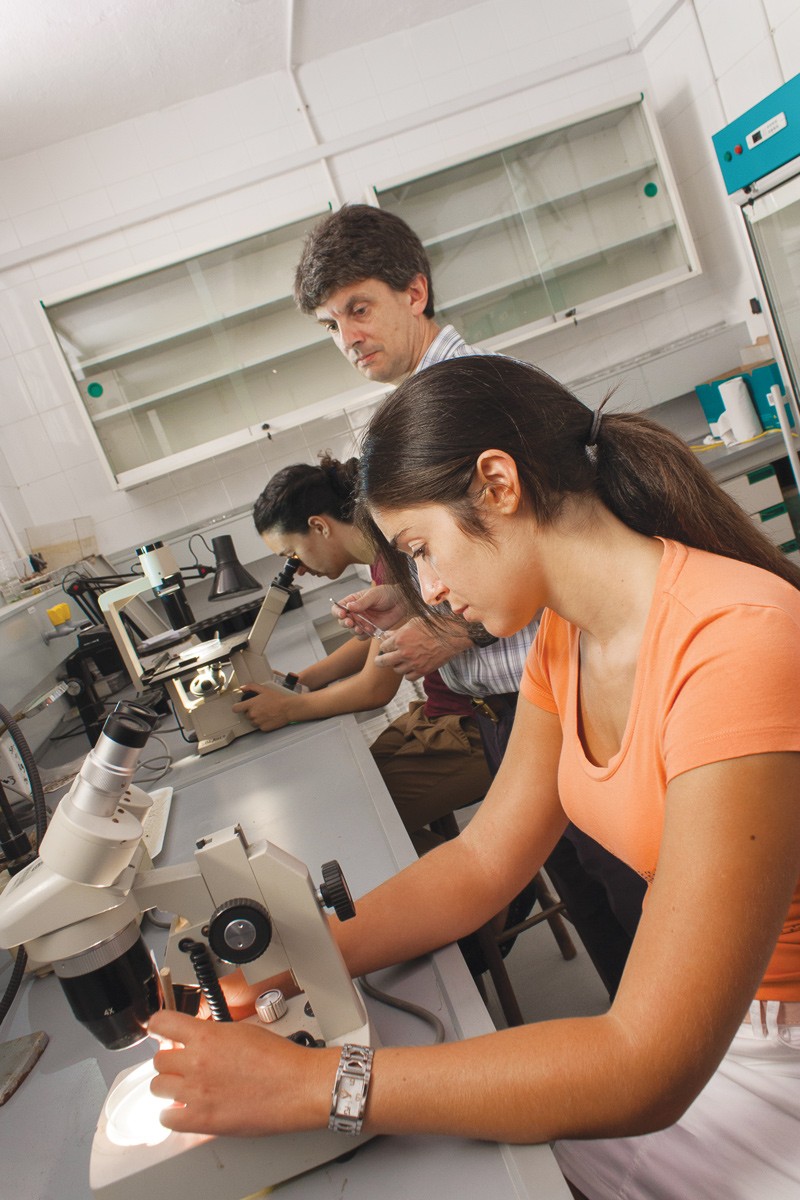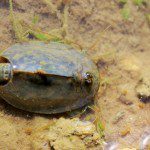Shrimps, water fleas, waterworts, and pondweeds, this is one wild party. Dry summers with temperatures of over 40 degrees in summer and flooded winters, life in a rockpool is not easy. Decades of research by local ecologists have shed light on this extreme habitat—Dr Sandro Lanfranco, Kelly Briffa, and Sheryl Sammut tell us more.
Crawling on all fours in the countryside whilst mumbling phrases in Latin is not generally considered a mainstream social norm. Behaviour like this is par for the course for a group of researchers whose efforts are focused on unravelling the secrets in temporary freshwater rock pools.
These pools form in small rocky hollows in the jagged terrain of the coralline limestone landscapes of the Maltese Islands. They fill with water following the first autumn rains in September or October and retain water continuously or intermittently, a phase called the ‘hydroperiod’, until drying out completely in April or May. This seasonal alternation between a dry and a flooded phase attracts three different classes of pool inhabitants: those that can only survive in water, those that can survive only in dry conditions, and those that can exploit conditions between dry and wet. Rock pools are a miniature natural laboratory where the seasonal cycle of life and death is played out. They tend to be small and scattered yet obey the same laws as larger habitats. By understanding how rock pools work we can grasp how larger and more complex habitats function.
Beauty sleep?

When the first autumn rains arrive, a survival race is triggered in rock pools. The first to hatch or germinate win. This race is largely hidden from view as it is played out in the sediment layer that accumulates at the bottom of a pool. This sediment—just ‘mud’—is vital for a pool’s ecosystem. It is a storehouse of seeds, eggs, and spores, all waiting for the right conditions to trigger their emergence into the outside world. This world is unkind.
The seeds of plants and the eggs of animals are in a dormant state during the dry phase and the breaking of dormancy is key. Most plant seeds and animal eggs are triggered by the same stimulus—water. But their responses differ slightly from species to species and even within clutches of seeds or eggs from the same species. It is these small divergences that represent the difference between success and failure, between life and death. The plants and animals that react first gobble up space, nutrients, food, and light that latecomers will miss out on. The breaking of dormancy comes with its own risks and needs careful timing. Erratic deluges or showers in late August or early September may briefly fill the pools with water before they dry out in the hot sunshine. Break dormancy this early and the existence of any plant or animal is doomed to be brief. The organisms would not have enough time to complete their life-cycle and give life to the next generation. The winners would be the late starters who need a lot more water or who respond to other cues such as temperature. In fact, most species respond best to a combination of prolonged wetting and lower temperatures. Life in this environment is unforgiving.
Suspended animation

The stakes are high in this race. Cryptobiosis is one of the most high-risk, high-stakes strategies. In this strategy, animals coat themselves with a protective cyst at the end of the wet season and enter a state of suspended animation. They remain in this protected state until the pools flood again the following autumn, at which time they emerge as adults. Being fully-grown they would be two steps ahead of other species that would still need to grow into adults after hatching. Of course, things do not always go according to plan. These animals die if the rain is inconsistent and the pools dry up again, or if it rains later than expected. The cryptobiotic animal may not be revived at all, in this case,and would die in the sediment at the bottom of the pool.
“The ultimate goal of all animals, all plants, all living organisms, is to pass on their genes”
The plants and animals that do manage to hatch or germinate face multiple challenges in this ephemeral environment. Rock pools tend to dry up quickly when rains stop. In Malta this can happen even in the winter months. The organisms that call rock pools their home have adapted by compressing all their life-cycle into the wet season. They quickly hatch and germinate, pass through a few phases, become adults, reproduce, and produce the next generation before the rock pools dry up.
The race to be the first to hatch or germinate is quickly followed by another race: that to be the first to reproduce. The ultimate goal of all animals, all plants, all living organisms, is to pass on their genes; the evolutionary success of any generation is measured by how many successful offspring it produces. In these temporary pools, reproduction has an added constraint: it has to happen while the pool actually exists, a short time window. Reproduction is efficient and rapid, with a large number of offspring produced. The plants are remarkable. They grow, flower, fruit, and set seed, in weeks rather than months. Any adaptation that buys them time may represent the difference between reproductive success and genetic death.
Shrimp Cocktail
Rock pool animals are both weird and wonderful. The Fairy Shrimps (Branchipus) are small, transparent shrimps that swim on their backs using multiple sets of appendages as flippers. The Clam Shrimps (Cyzicus) are mostly bottom dwellers, usually half-buried in the sediment, where they feed on organic matter. The ostracods (Cypris, Eucypris and others), also shrimps, are small and seed-like and scurry around the bottom of the pool mopping up everything in their path—nature’s great scavengers. In the water column, water fleas (Daphnia, Ceriodaphnia) of many kinds bob up and down feeding on plankton.
“Females dominate this shrimp-world. They rule since evolution partially got rid of the males”

Females dominate this shrimp-world. They rule since evolution got rid of the males, at least partially. These shrimps mostly reproduce by asexual reproduction making copies of themselves. This reduces genetic variety but also removes one of the costs of sex: slow population growth. Males cannot give birth to offspring, and therefore halve the number of progeny. When the pool is full of water and stable, animals need to reproduce but genetic variety is not so important in a stable habitat. So, during the wet season, these females simply produce plenty of asexual eggs that grow into other females. Things change as things get drier. Spring brings less frequent rainfall, rising temperatures, and falling water levels. These aquatic shrimps are in trouble since their habitat is disappearing. In this stressful time, males appear. Some eggs hatch into males, sometimes merely dwarf males, whose only task is to fertilise females. This last hurrah now produces eggs that differ genetically from each other and that have thick outer walls, resistant to drought. These are the eggs that will try to survive the hot, waterless summer, where soil temperatures regularly exceed 40°C. The length of the dry phase is unpredictable and is the reason why genetic variety is now so important. Different eggs or seeds have different hatching or germination needs, meaning that some will burst into life at the first drop of water, while others need plenty of water and cooler temperatures. By hatching at different times there will always be some that survive the following autumn.
Green fingers
The plants that live in these pools have to cope with the two principal problems faced by all plants on Earth: either too little water, or too much of it. During the wet season, the pool is flooded, and would therefore favour hydrophytes: plants that can survive submerged in water. These plants, rooted in the bottom sediment, are often delicate and fragile, with linear, finger-like leaves. They have no need for elaborate support structures as the water they live in provides this function.
Another group of plants, the amphiphytes, can have the best of both worlds. They live in water, but can also survive short dry periods. They have the wispy leaves of aquatic plants but also, later on in the wet season when the pools are drying out, the broader, stouter leaves of land plants. Because of these adaptations the plants can live where no other plant can: the boundary zone between dry and wet. This adaptation extends the plants’ life-cycle by a few critical days at the end of the wet season, giving them some more time to reproduce and release their seeds—the next generation—into the sediment for the next wet season. As long as the soil is moist, amphiphytes can survive. But when the soil dries out completely even the amphiphytes disappear leaving just their seeds. The dry pool is now the realm of terrestrial plants that are encroaching from the surrounding dry land, and of scavenging animals, such as woodlice and ants, feeding on the remains of the dead aquatic animals.
“These habitats are treasure troves of biological diversity. The plants and animals that live there are comparatively rare, because their habitat is also rare “
Time and Space Travel
Plant seeds and animal eggs are resistant, self-contained time capsules that allow survival through periods of environmental stress. In their most basic form seeds and eggs consist of an embryo, a food supply, and a tough, protective outer covering. In this state, embryos can bide their time and emerge in favourable conditions. For plants and animals that live in rock pools, ‘favourable’ conditions imply rain and a drop in temperature. Since this aquatic phase depends on an unpredictable climate, embryos may sometimes need to wait for a long time before breaking dormancy and emerging. They cannot wait forever. The genetic differences between seeds and eggs from the same species mean that some are able to remain viable in the dormant state for much longer than others. Some may only tolerate a few weeks or months of waiting; others may, in the style of Rip Van Winkle, wait successfully for years or even decades before emerging. These are nature’s incomparable time-travellers. This longevity of dormancy gives some of the pool inhabitants extraordinary resilience. Almost miraculously, they will spring back to life after a long succession of unfavourable years. Some seeds and eggs lie in reserve waiting for that downpour and temperature drop.
Seeds and eggs are also a means of travelling from place to place, and both animals and plants generally devote much effort to ensure that their seeds disperse widely. Dispersal allows species to colonise new territories and therefore hedge their survival bets in multiple spots. Rock pool species do not follow this trend. They simply leave or lay their seeds and eggs in the bottom sediment without trying to disperse offspring far and wide. This evolutionary trend is explained by the nature of the rock pool habitat. A pool is an island of ‘favourable’ habitat within a much larger area of ‘unfavourable’ terrain. If seeds and eggs travel far, they will disperse beyond the boundary of the pool and into inhospitable territory where they cannot germinate or hatch. Offspring that travel far are not likely to survive. There are exceptions. Pools attract other animals, including birds. When birds wade in a pool, someof the bottom mud—containing seeds and eggs—may stick to their feet. When the bird takes flight, the seeds and eggs do so too, and in this waymay travel very long distances into other wetlands.
This evolutionary trend is explained by the nature of the rock pool habitat. A pool is an island of ‘favourable’ habitat within a much larger area of ‘unfavourable’ terrain. If seeds and eggs travel far, they will disperse beyond the boundary of the pool and into inhospitable territory where they cannot germinate or hatch. Offspring that travel far are not likely to survive. There are exceptions. Pools attract other animals, including birds. When birds wade in a pool, someof the bottom mud—containing seeds and eggs—may stick to their feet. When the bird takes flight, the seeds and eggs do so too, and in this waymay travel very long distances into other wetlands.
Vital rockpools
Rock pools are small and scattered, why should they be considered important? These habitats are treasure troves of biological diversity. The plants and animals that live there are comparatively rare, because their habitat is also rare. They are at the merciless hands of extinction.Rock pools are whole ecosystems in miniature. They can be used to test different ideas in ecological theory without many of the complications and additional factors present in larger ecosystems, like a whole forest or swamp.
These pools could survive a warming climate. Global warming is already rapidly changing the environment. The short life-cycles of pool organisms means that they should respond quickly to change and adapt successfully. Larger systems might not adapt in time. The effects of global warming are observable in pools long before more complex ecosystems.Our research group wants to answer all of these questions. Early studies characterised rock pool habitats in Malta, their species and dynamics. A later study showed how these pools can be used as an early-warning system for global warming. A consistent temperature increase will increase the number of amphiphytes while decreasing hydrophytes. The ratio between these two plant types is an indicator of climatic change. More recent work focused on specific aspects of the pool environment or on individual species. Another study investigated the germination requirements of pool plants to try and understand which stimuli promote the presence of particular species over others. A number of more recent studies have been looking into how the species present in a pool are affected by the location of pools in an area, the pool basin’s shape, and of the length of hydroperiod.
These studies have answered some questions but raised plenty of others. It seems that there will be students crawling on all fours and mumbling in Latin for some time yet.






Comments are closed for this article!